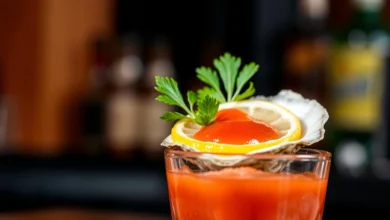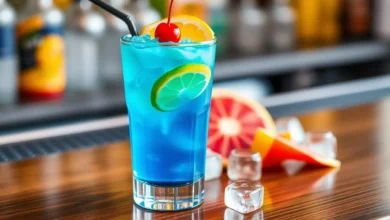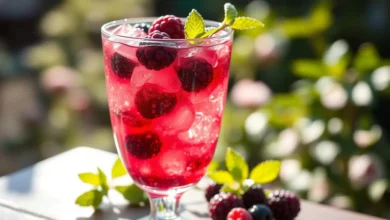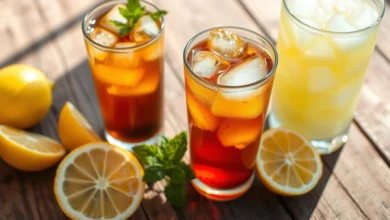Is Prosecco Champagne? Sparkling Wine Explained
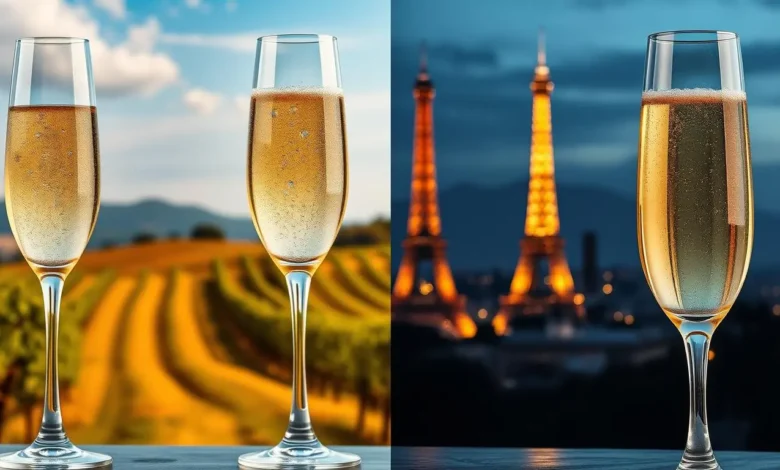
In the world of sparkling wines, Prosecco and Champagne are two big names. They are loved for their bubbly charm but are very different. Let’s dive into what makes them unique.
Defining Champagne and Prosecco
Champagne and Prosecco are both sparkling wines, but they are different. Champagne comes from the Champagne region in France. It’s made with specific grapes and a traditional method called “methode champenoise.”
Prosecco is from Italy, mainly from the Veneto and Friuli Venezia Giulia regions. It’s made mostly from the Glera grape, using the Charmat or tank method.
Understanding the Legal Requirements
To be called Champagne, a wine must follow strict rules. These are set by the Comité Interprofessionnel du Vin de Champagne (CIVC). They cover grape varieties, production methods, and aging.
Prosecco producers in Italy have their own rules. These are set by the Prosecco DOC and DOCG governing bodies.
Geographical Origins and Production Methods
Champagne and Prosecco have different terroirs and production methods. Champagne is made with a traditional, second fermentation in the bottle. This is a labor-intensive process.
Prosecco, on the other hand, is made using the Charmat or tank method. This is faster and cheaper. These different methods give each wine its unique taste and character.
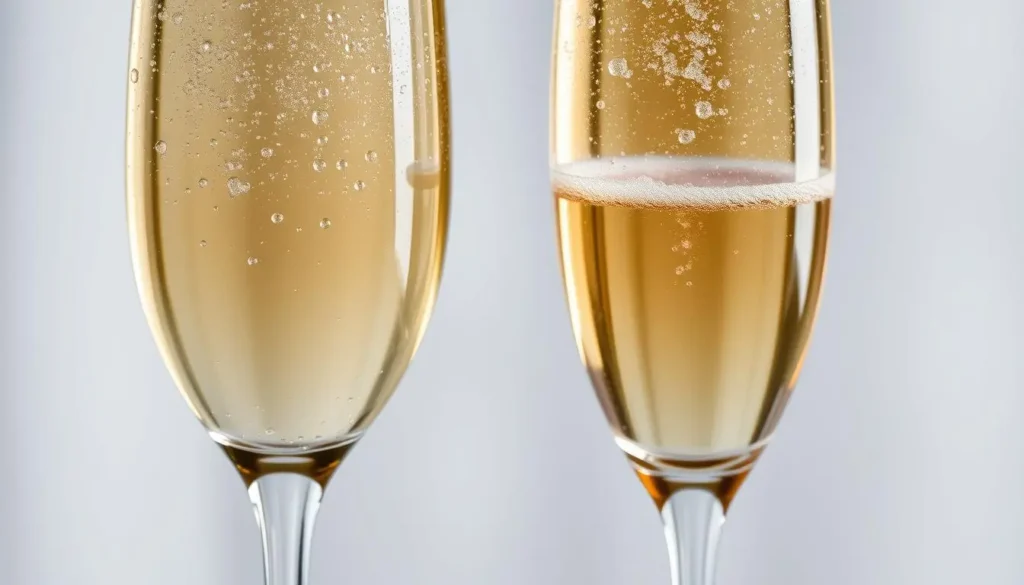
“Champagne and Prosecco may both be sparkling wines, but they are distinctly different in their origins, production, and resulting flavors.”
The Differences Between Champagne and Prosecco
Both is prosecco champagne and is prosecco sparkling wine champagne are different in many ways. Knowing the differences between Champagne and Prosecco helps you choose the right one. This choice depends on your taste and the event.
Champagne is made through a secondary fermentation in the bottle. This makes it taste more complex and have a finer foam. Prosecco, however, is made using the Charmat method. It tastes lighter and fruitier, making it more accessible.
The grapes used also differ. Champagne is mainly made from Chardonnay, Pinot Noir, and Pinot Meunier. Prosecco is mostly made from Glera grapes, giving it a distinct taste.
| Characteristic | Champagne | Prosecco |
|---|---|---|
| Production Method | Secondary fermentation in bottle | Charmat (tank) method |
| Grape Varieties | Chardonnay, Pinot Noir, Pinot Meunier | Glera |
| Flavor Profile | Complex, yeast-driven, elegant | Lighter, fruitier, approachable |
| Mousse (Foam) | Finer, more persistent | Lighter, more delicate |
Knowing these differences helps you pick the right Champagne or Prosecco. Whether you want a fancy, elegant wine or a casual, easy-drinking one, there’s a choice for you.
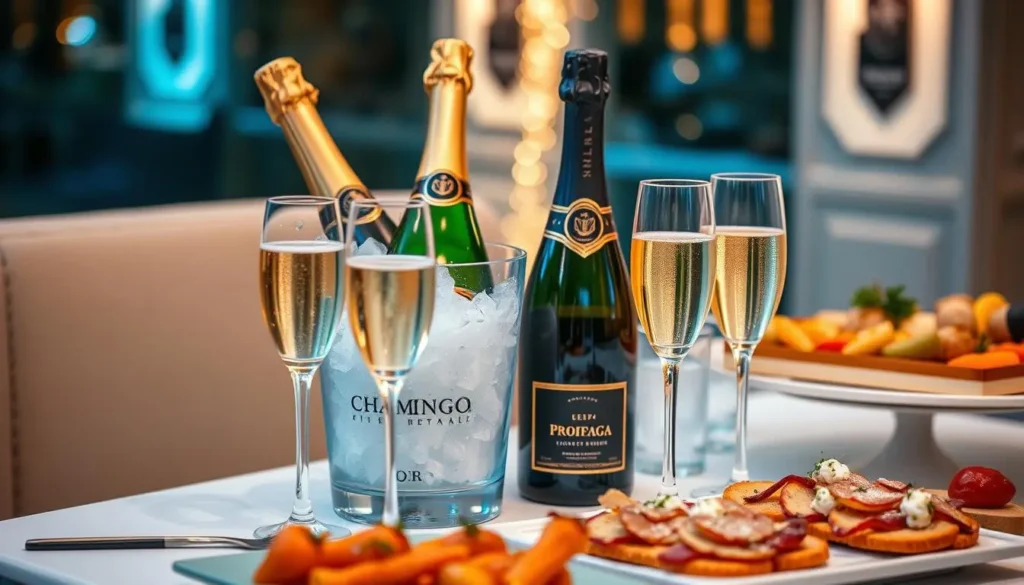
Prosecco: The Italian Sparkling Wine
Prosecco is a popular Italian sparkling wine loved worldwide. It’s made mainly from the Glera grape, giving it a crisp, fruity taste. Whether you’re new to is prosecco champagne or a seasoned fan, Prosecco is a great way to explore Italy’s wine culture.
Grape Varieties and Styles
Prosecco comes in many styles, from dry to sweet. The Glera grape is key, adding flavors like green apple and pear. Some wines also include Verdiso or Bianchetta Trevigiana for extra complexity.
Prosecco Production Regions
- Most Prosecco comes from Veneto and Friuli Venezia Giulia in northeastern Italy. The top areas are Prosecco di Valdobbiadene and Prosecco di Conegliano.
- These places have different soils and climates, making each is prosecco champagne unique.
- The hills of Valdobbiadene and Conegliano show off Italy’s sparkling wine excellence.
“Prosecco has become a global phenomenon, captivating wine enthusiasts with its vibrant, approachable, and versatile style.”
Enjoy prosecco with seafood or as a celebratory drink. Its crisp flavors and bubbly make it a joy for wine lovers.
Champagne: The French Sparkling Wine Icon
Champagne is the top sparkling wine known worldwide. It comes from the Champagne region in France. This wine is linked Drinks with luxury, celebrations, and the best of life. Its quality and taste come from old ways of making it and special grapes.
Traditional Champagne Grapes
The main grapes for Champagne are Chardonnay, Pinot Noir, and Pinot Meunier. Each grape adds its own flavor to the mix. This makes Champagne a unique and exciting drink.
- Chardonnay gives Champagne its light, elegant taste. It adds a crispness and finesse.
- Pinot Noir brings depth and a hint of red fruit. It makes the wine more complex and full.
- Pinot Meunier adds a burst of fruitiness. It balances the wine and makes it fresh.
The mix of these grapes and the special second fermentation in the bottle make Champagne special. It stands out from other is prosecco sparkling wine champagne or prosecco wines.
“Champagne is the only wine that leaves a woman beautiful after drinking it.”
– Madame de Pompadour
is prosecco champagne?
Prosecco and champagne are both sparkling wines, but they are different. Prosecco comes from Italy, mainly from Veneto and Friuli Venezia Giulia. On the other hand, champagne must be made in France’s Champagne region, following strict rules.
The way they’re made also sets them apart. Champagne is fermented a second time in the bottle. This makes it taste more complex and elegant. Prosecco, however, is made using the Charmat or tank method. It tastes crisp, fruity, and easy to drink.
| Prosecco | Champagne |
|---|---|
| Produced in Italy, primarily in the Veneto and Friuli Venezia Giulia regions | Produced in the Champagne region of France |
| Made using the Charmat or tank method | Undergoes a second fermentation in the bottle |
| Typically exhibits a crisp, fruity, and approachable flavor profile | Often has a more complex and elegant taste |
In summary, prosecco and champagne are both sparkling wines but different. Prosecco is not champagne because it doesn’t meet the legal standards for champagne.
The Taste and Aroma Profiles
Prosecco and champagne have unique tastes and smells. Prosecco, from Italy, is known for its crisp and fruity flavors. You might taste green apple, pear, white peach, and citrus in it.
Champagne, from France, is famous for its complex and elegant tastes. It often has notes of brioche, yeast, and fruits like red and stone. It also has a subtle minerality, making it sophisticated and refined.
Prosecco’s Crisp and Fruity Flavors
Prosecco is vibrant, refreshing, and easy to drink. Its crisp acidity and lively bubbles make it fun to drink. The fruity flavors add a sweet charm, making it great with many foods.
Champagne’s Complex and Elegant Notes
Champagne is known for its complex taste. It has yeasty, biscuit-like smells and fruity flavors. The fine bubbles and mousse make it luxurious and perfect for celebrations.
| Characteristic | Prosecco | Champagne |
|---|---|---|
| Dominant Flavors | Green apple, pear, white peach, citrus | Brioche, yeast, red and stone fruits, minerality |
| Mouthfeel | Crisp, bright, and refreshing | Complex, elegant, and refined |
| Overall Character | Vibrant, easy-to-drink, and versatile | Sophisticated, luxurious, and celebratory |
“Prosecco is like a sunny day in a glass, while champagne is like a symphony of flavors.”
Food Pairing Suggestions
When pairing food with prosecco and champagne, their unique flavors offer different culinary experiences. Prosecco is great with lighter dishes like seafood, salads, and appetizers. Its bright, fruity taste shines in these pairings. On the other hand, champagne complements a variety of dishes, including richer foods like roasted meats and creamy sauces.
Here are some pairing suggestions to enhance your prosecco and champagne enjoyment:
- Prosecco with Seafood: Its crisp acidity and citrusy notes pair well with fresh seafood, like oysters and shrimp.
- Prosecco with Salads: Its light, refreshing taste complements leafy greens, fruits, and light dressings.
- Prosecco with Appetizers: It pairs well with a variety of appetizers, from cured meats to bruschetta.
- Champagne with Roasted Meats: Its complex profile stands up to the flavors of roasted meats, such as beef and pork.
- Champagne with Creamy Sauces: Its acidity and effervescence balance the richness of creamy sauces.
- Champagne with Desserts: It surprisingly pairs well with fruity or citrusy desserts.
The secret to great pairings is to match the wine’s flavor with the dish’s. Experiment to find your favorite combinations.
Occasions and Celebrations
Prosecco: Versatile and Approachable
When it comes to celebrations, both prosecco and champagne have their spots. Prosecco is great for casual events, brunches, and everyday fun. It’s easy to drink and has a lively taste that goes well with many foods.
Champagne, on the other hand, is for more formal events like weddings and New Year’s Eve. It’s seen as elegant and sophisticated, fitting for grand occasions.
“Prosecco is the perfect sparkling wine for any occasion, from a relaxed Sunday brunch to a lively girls’ night out. Its fresh and approachable style makes it a crowd-pleaser that won’t break the bank.”
Looking to add elegance to an event or just want a bubbly drink? Both prosecco and champagne are great. It all depends on what you’re looking for and the mood you want to set.
Champagne: A Symbol of Luxury and Prestige
When we talk about is prosecco champagne or is prosecco sparkling wine champagne, Champagne stands out. It’s known for its luxury and prestige. This is because of its special production and where it comes from in France.
Champagne is the top choice for big celebrations, like prosecco weddings and important business deals. Its making process is complex and time-consuming. This makes Champagne unique and exclusive.
“Champagne represents the height of luxury and celebration, a symbol of success and the finer things in life.”
The Champagne region has a long history of winemaking. This, along with careful production, makes Champagne the most respected sparkling wine globally. Its famous bottle and labels show its status as a luxury item.
Enjoying Champagne, whether at a big event or a quiet moment, shows off your taste. It’s linked to success, wealth, and luxury. This makes Champagne the top sparkling wine, a true symbol of luxury.
Price Comparison and Value
When looking at is prosecco champagne and is prosecco sparkling wine champagne, the price is key. Prosecco, the Italian sparkling wine, is cheaper than the French Champagne.
Prosecco is easy to find at a good price. This makes it a favorite for those wanting a bubbly drink without spending a lot. Its affordability has made prosecco more popular among wine lovers.
| Feature | Prosecco | Champagne |
|---|---|---|
| Average Bottle Price | $15 – $30 | $40 – $100+ |
| Production Method | Charmat (Tank) Method | Traditional Méthode Champenoise |
| Grape Varieties | Glera | Chardonnay, Pinot Noir, Pinot Meunier |
| Region | Veneto and Friuli Venezia Giulia, Italy | Champagne, France |
Champagne is seen as a more expensive and luxurious choice. Its prices are often much higher than prosecco. This is because of the hard work and prestige of the Champagne region.
Choosing between prosecco and Champagne depends on what you like, how much you want to spend, and the event. Both provide special and enjoyable sparkling wine experiences, fitting different tastes and budgets.
Conclusion
Prosecco and Champagne are both sparkling wines, but they are different. Prosecco comes from Italy and is known for its crisp, fruity taste. Champagne, from France, is famous for its complex flavors and elegance.
Knowing the differences helps you choose the right wine for any event. Whether you like Prosecco’s lively taste or Champagne’s sophisticated notes, both can make any celebration special.
So, whether you’re choosing between Prosecco and Champagne, it’s all about what you like and the event. Exploring these wines can help you find the perfect one for your celebrations.
FAQ
Is Prosecco Champagne?
No, Prosecco is not Champagne. They are both sparkling wines but come from different places and are made differently. Champagne must be made in France, following strict rules. Prosecco, on the other hand, is made in Italy, mainly in Veneto and Friuli Venezia Giulia.
Champagne is made with a second fermentation in the bottle. Prosecco is made using the Charmat or tank method.
Is Prosecco a Sparkling Wine Like Champagne?
Yes, Prosecco is a sparkling wine, but it’s not Champagne. Both are bubbly, but they taste and feel different. Champagne has complex flavors and a finer bubble. Prosecco is known for its fresh, fruity taste and a softer bubble.
What are the Differences Between Prosecco and Champagne?
Prosecco and Champagne differ in several ways: 1. Where they are made: Champagne comes from France, while Prosecco is from Italy. 2. How they are made: Champagne is made with a second fermentation in the bottle. Prosecco is made using the Charmat or tank method. 3. The grapes used: Champagne is made from Chardonnay, Pinot Noir, and Pinot Meunier. Prosecco is mostly made from Glera grapes. 4. Taste: Champagne has complex flavors and a finer bubble. Prosecco is known for its fresh, fruity taste and a softer bubble.
What is the Difference Between Prosecco and Champagne in Taste?
Prosecco and Champagne taste and smell differently: – Prosecco tastes bright and fruity, with notes of green apple, pear, and citrus. – Champagne has complex aromas and flavors, with notes of brioche, yeast, and red and stone fruits.
Which is More Expensive, Prosecco or Champagne?
Champagne is usually pricier than Prosecco. This is because making Champagne is more labor-intensive and it’s seen as more prestigious. Prosecco is often cheaper, offering quality at a lower price. The price difference comes from the production methods, grape varieties, and the luxury perception of each wine.
